

Renaissance. The Renaissance (UK /rɨˈneɪsəns/, US /ˈrɛnɨsɑːns/, French pronunciation: [ʁənɛsɑ̃s], from French: Renaissance "re-birth", Italian: Rinascimento, from rinascere "to be reborn")[1] was a cultural movement that spanned the period roughly from the 14th to the 17th century, beginning in Italy in the Late Middle Ages and later spreading to the rest of Europe.

Though availability of paper and the invention of metal movable type sped the dissemination of ideas from the later 15th century, the changes of the Renaissance were not uniformly experienced across Europe. In politics, the Renaissance contributed the development of the conventions of diplomacy, and in science an increased reliance on observation. Historians often argue this intellectual transformation was a bridge between the Middle Ages and Modern history. Overview[edit] The Renaissance was a cultural movement that profoundly affected European intellectual life in the early modern period. Origins[edit] Black Death/Plague[edit] Glossary Definition: Reformation. A term covering a number of changes in Western Christianity (Europe) between the 14th and 17th centuries, resulting in the split in Christianity between Roman Catholicism and Protestantism.
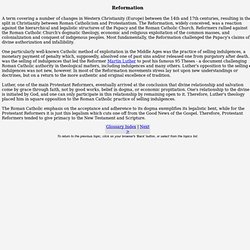
The Reformation, widely conceived, was a reaction against the hierarchical and legalistic structures of the Papacy and the Roman Catholic Church. Reformers rallied against the Roman Catholic Church's dogmatic theology, economic and religious exploitation of the common masses, and colonialization and conquest of indigenous peoples. Most fundamentally, the Reformation challenged the Papacy's claims of divine authorization and infallibility. One particularly well-known Catholic method of exploitation in the Middle Ages was the practice of selling indulgences, a monetary payment of penalty which, supposedly, absolved one of past sins and/or released one from purgatory after death.
THE COUNTER REFORMATION. In the sixteenth century the Roman church undertook to reform itself.

This reform movement, extending into the following century, raised the moral and educational standards of the clergy; inspired the church with a renewed zeal and morale, which enabled it to win back areas endangered by Protestantism; and contributed significantly to producing the Catholic church as we know it today. The chief agencies in carrying out this work were the papacy, which was much different from the papacy of the Renaissance; a group of religious orders, some reformed and some new, most notably the Society of Jesus, or Jesuits; and the Council of Trent. Medici: Godfathers of the Renaissance . Renaissance . Counter Reformation. Throughout the middle ages the Catholic Church sunk deeper into a pit of scandal and corruption.
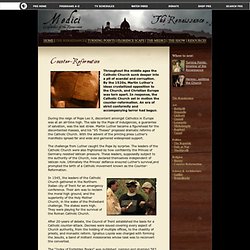
By the 1520s, Martin Luther's ideas crystallized opposition to the Church, and Christian Europe was torn apart. In response, the Catholic Church set in motion the counter-reformation. An era of strict conformity and accompanying terror had begun. During the reign of Pope Leo X, discontent amongst Catholics in Europe was at an all-time high. The Counter-Reformation. The subject will be considered under the following heads: I.
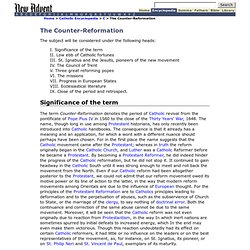
Significance of the term II. Low ebb of Catholic fortunes III. St.
Counter-Reformation. A copy of the Vulgate (the Latin edition of the Catholic Bible) printed in 1590, after many of the Council's reforms had begun to take place in Catholic worship.
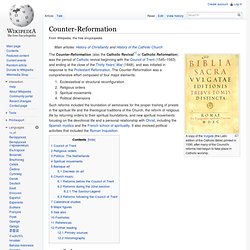
The Counter-Reformation (also the Catholic Revival[1] or Catholic Reformation) was the period of Catholic revival beginning with the Council of Trent (1545–1563) and ending at the close of the Thirty Years' War (1648), and was initiated in response to the Protestant Reformation. The Counter-Reformation was a comprehensive effort composed of four major elements: Ecclesiastical or structural reconfigurationReligious ordersSpiritual movementsPolitical dimensions Council of Trent[edit] A session of the Council of Trent, from an engraving. Pope Paul III (1534–1549) initiated the Council of Trent (1545–1563), a commission of cardinals tasked with institutional reform, addressing contentious issues such as corrupt bishops and priests, indulgences, and other financial abuses.
Religious orders[edit] THE REFORMATION AND COUNTER-REFO. By James Jackson Background At the beginning of the sixteenth century, the Catholic church, modeled upon the bureaucratic structure of the Holy Roman Empire, had become extremely powerful, but internally corrupt.
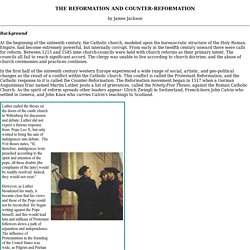
From early in the twelfth century onward there were calls for reform. Between 1215 and 1545 nine church-councils were held with church reforms as their primary intent. The councils all fail to reach significant accord.